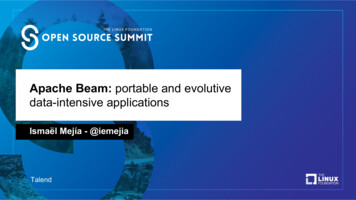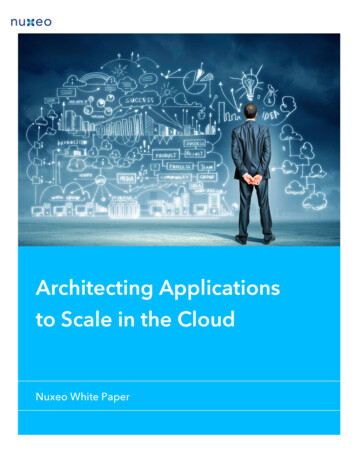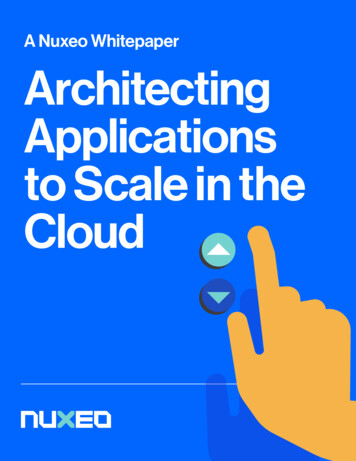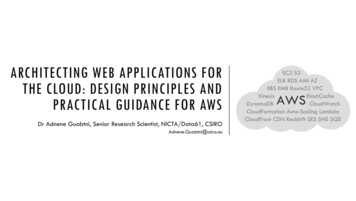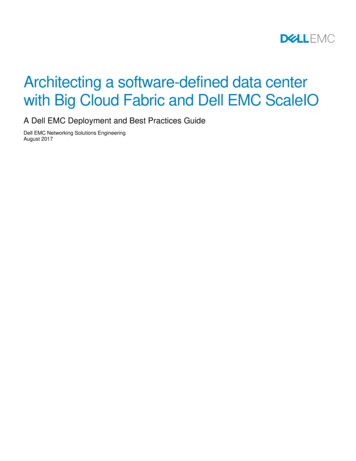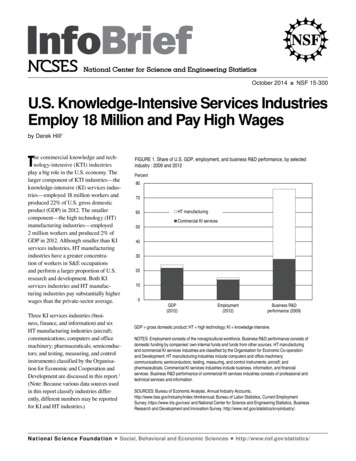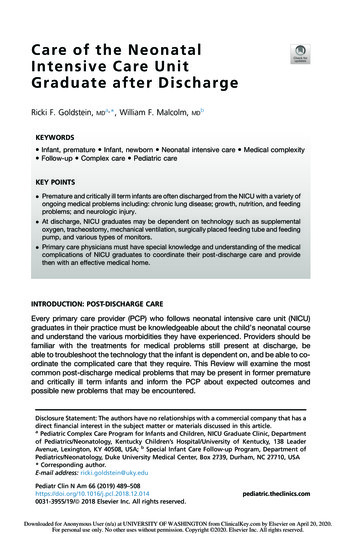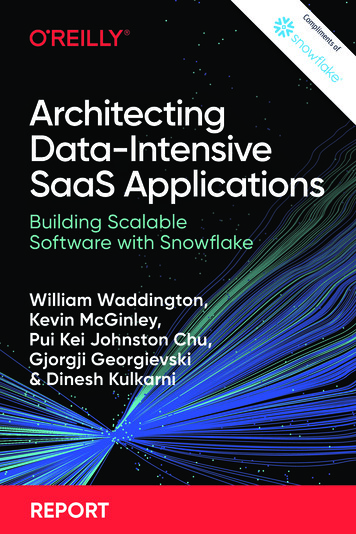
Transcription
ComplimentsofArchitectingData-IntensiveSaaS ApplicationsBuilding ScalableSoftware with SnowflakeWilliam Waddington,Kevin McGinley,Pui Kei Johnston Chu,Gjorgji Georgievski& Dinesh KulkarniREPORT
Architecting Data-IntensiveSaaS ApplicationsBuilding Scalable Softwarewith SnowflakeWilliam Waddington, Kevin McGinley,Pui Kei Johnston Chu, Gjorgji Georgievski,and Dinesh KulkarniBeijingBoston Farnham SebastopolTokyo
Architecting Data-Intensive SaaS Applicationsby William Waddington, Kevin McGinley, Pui Kei Johnston Chu, GjorgjiGeorgievski, and Dinesh KulkarniCopyright 2021 O’Reilly Media, Inc. All rights reserved.Printed in the United States of America.Published by O’Reilly Media, Inc., 1005 Gravenstein Highway North, Sebastopol, CA95472.O’Reilly books may be purchased for educational, business, or sales promotional use.Online editions are also available for most titles (http://oreilly.com). For more infor‐mation, contact our corporate/institutional sales department: 800-998-9938 orcorporate@oreilly.com.Acquisitions Editor: Jessica HabermanDevelopment Editor: Michele CroninProduction Editor: Christopher FaucherCopyeditor: Rachel HeadMay 2021:Proofreader: Tom SullivanInterior Designer: David FutatoCover Designer: Kenn VondrakIllustrator: Kate DulleaFirst EditionRevision History for the First Edition2021-04-30:First ReleaseThe O’Reilly logo is a registered trademark of O’Reilly Media, Inc. Architecting DataIntensive SaaS Applications, the cover image, and related trade dress are trademarksof O’Reilly Media, Inc.The views expressed in this work are those of the authors, and do not represent thepublisher’s views. While the publisher and the authors have used good faith effortsto ensure that the information and instructions contained in this work are accurate,the publisher and the authors disclaim all responsibility for errors or omissions,including without limitation responsibility for damages resulting from the use of orreliance on this work. Use of the information and instructions contained in thiswork is at your own risk. If any code samples or other technology this work containsor describes is subject to open source licenses or the intellectual property rights ofothers, it is your responsibility to ensure that your use thereof complies with suchlicenses and/or rights.This work is part of a collaboration between O’Reilly and Snowflake. See our state‐ment of editorial independence.978-1-098-10273-9[LSI]
Table of Contents1. Data Applications and Why They Matter. . . . . . . . . . . . . . . . . . . . . . . . 1Data Applications DefinedCustomer 360IoTMachine Learning and Data ScienceApplication Health and SecurityEmbedded AnalyticsSummary34567892. What to Look For in a Modern Data Platform. . . . . . . . . . . . . . . . . . . 11Benefits of Cloud EnvironmentsCloud-First Versus Cloud-HostedChoice of Cloud Service ProvidersSupport for Relational DatabasesBenefits of Relational DatabasesSeparation of Storage and ComputeData SharingWorkload IsolationAdditional 41515161919222223243. Building Scalable Data Applications. . . . . . . . . . . . . . . . . . . . . . . . . . . 25Design Considerations for Data ApplicationsDesign Patterns for StorageDesign Patterns for Compute252629iii
Design Patterns for SecuritySummary32364. Data Processing. . . . . . . . . . . . . . . . . . . . . . . . . . . . . . . . . . . . . . . . . . . . 37Design ConsiderationsRaw Versus Conformed DataData Lakes and Data WarehousesSchema EvolutionOther Trade-offsBest Practices for Data ProcessingETL Versus ELTSchematizationLoading DataServerless Versus serverfulBatch Versus StreamingSummary3738383940414142434343475. Data Sharing. . . . . . . . . . . . . . . . . . . . . . . . . . . . . . . . . . . . . . . . . . . . . . 49Data Sharing ApproachesSharing by CopySharing by ReferenceDesign ConsiderationsSharing Data with UsersGetting Feedback from UsersData Sharing in SnowflakeSnowflake Data MarketplaceSnowflake Secure Data Sharing in Action: BrazeSummary495051525253535556576. Summary and Further Reading. . . . . . . . . . . . . . . . . . . . . . . . . . . . . . . 59iv Table of Contents
CHAPTER 1Data Applications andWhy They MatterIn the last decade we’ve seen explosive growth in data, driven byadvances in wireless connectivity, compute capacity, and prolifera‐tion of Internet of Things (IoT) devices. Data now drives significantportions of our lives, from crowdsourced restaurant recommenda‐tions to artificial intelligence systems identifying more effectivemedical treatments. The same is true of business, which is becomingincreasingly data-driven in its quest to improve products, opera‐tions, and sales. And there are no signs of this trend slowing down:market intelligence firm IDC predicts the volume of data createdeach year will top 160 ZB by 2025,1 a tenfold increase over theamount of data created in 2017.This enormous amount of data has spurred the growth of dataapplications—applications that leverage data to create value for cus‐tomers. Working with large amounts of data is a domain unto itself,requiring investment in specialized platforms to gather, organize,and surface that data. A robust and well-designed data platform willensure application developers can focus on what they do best—cre‐ating new user experiences and platform features to help their cus‐tomers—without having to spend significant effort building andmaintaining data systems.1 r-from-it1
We created this report to help product teams, most of which are notwell versed in working with significant volumes of fast-changingdata, to understand, evaluate, and leverage modern data platformsfor building data applications. By offloading the work of data man‐agement to a well-designed data platform, teams can focus on deliv‐ering value to their customers without worrying about datainfrastructure concerns.This first chapter provides an introduction to data applications andsome of the most common use cases. For each use case, you willlearn what features a data platform needs to best support data appli‐cations of this type. This understanding of important data platformfeatures will prepare you for Chapter 2, where you will learn how toevaluate modern data platforms, enabling you to confidently con‐sider the merits of potential solutions. In Chapter 3 we’ll exploredesign considerations for scalability, a critical requirement for meet‐ing customer demand and enabling rapid growth. This chapterincludes examples to show you how to put these best practices intoaction. Chapter 4 covers techniques for efficiently transforming rawdata within the context of a data application and includes real-worldexamples. In addition to consuming data, teams building effectivedata applications need to consider how to share data with customersor partners, which you will learn about in Chapter 5. Finally, we willconclude in Chapter 6 with key takeaways and suggestions for fur‐ther reading.Throughout this report we provide examples of how to build dataapplications using Snowflake, a modern platform that enables dataapplication developers to realize the full potential of the cloud whilereducing costs and simplifying infrastructure.The Snowflake Data Cloud is a global network wherethousands of organizations mobilize data with nearunlimited scale, concurrency, and performance.2 Insidethe Data Cloud, organizations unite their siloed data,easily discover and securely share governed data, andexecute diverse analytic workloads. Wherever data orusers live, Snowflake delivers a single, seamless experi‐ence across multiple public clouds.2 https://www.snowflake.com2 Chapter 1: Data Applications and Why They Matter
Data Applications DefinedData applications are customer- or employee-facing applicationsthat process large volumes of complex and fast-changing data,embedding analytics capabilities that allow users to harness theirdata directly within the application. Data applications are typicallybuilt by software companies that market their applications to otherbusinesses. As you learn about some of the most common use casesof data applications in this chapter, you will get a sense of thebreadth of this landscape. Truly, we are living in a time when mostapplications are becoming data applications.Retail tracking systems, such as those used by grocery stores to trackshopping habits and incentivize shoppers, are data applications.Real-time financial fraud detection, assembly line operation moni‐toring, and machine learning systems improving security threatdetection are all data applications. Data applications embed tools,including dashboards and data visualizations, that enable customersto better understand and leverage their data. For example, an onlinepayments platform with an integrated dashboard enables businessesto analyze seasonal trends and forecast inventory needs for the com‐ing year.As shown in Figure 1-1, data applications provide these services byembedding data platforms to process a wide variety of datasets,making this data actionable to customers and partners through auser interface layer.Figure 1-1. Data applicationsData Applications Defined 3
In the following sections we’ll review five of the most common usecases of data applications. For each case we will highlight key dataplatform considerations, which we will then cover in more detail inChapter 2.Common Data Application Use CasesThe use cases we will cover are:Customer 360Applications in marketing or sales automation that require acomplete view of the customer relationship to be effective.Examples include targeted email campaigns and generatingpersonalized offers using historical and real-time data.IoT (Internet of Things)Applications that use large volumes of time-series data fromIoT devices and sensors to make predictions or decisions innear real time. Inventory management and utility monitoringare examples of IoT data applications.Application health and securityApplications for identification of potential security threats andmonitoring of application health through analysis of large vol‐umes of current and historical data. Examples include analyz‐ing logs to predict threats and real-time monitoring ofapplication infrastructure to prevent downtime.Machine learning and data scienceApplications focusing on the training and deployment ofmachine learning models in order to build predictive applica‐tions, such as recommendation engines based on purchase his‐tory and clickstream data.Embedded analyticsData-intensive applications that deliver branded analysis andvisualizations, enabling users to leverage insights within thecontext of the application.Customer 360From clickstreams telling the story of how a user engages digitally toenriching customer information with third-party data sources, it isnow possible to get a holistic, 360-degree view of customers.4 Chapter 1: Data Applications and Why They Matter
Bringing together data on customers enables highly personalized,targeted advertising and customer segmentation, leading to moreopportunities to cross-sell and upsell. Both through better under‐standing of customers and by taking advantage of machine learning,you can create compelling experiences to drive conversion.The challenge with Customer 360 applications is dealing with themassive amount and variety of data available. Basic data, includingcontact and demographic information, can be purchased fromthird-party sources. As this data tends to be stored in customer rela‐tionship management (CRM) solutions, it is typically well struc‐tured, available as an export at a point of time or via an API.Interaction data shows how a customer interacts with digital con‐tent. This can include tracking interaction with links in marketingemails, counting the number of times a whitepaper is downloaded,and using web analytics to understand the path users take through awebsite. Interaction data is typically semi-structured and requiresmore data processing to realize its value.Realizing value from customer data involves bringing together thevarious data types to run analysis and build machine learning mod‐els. To support these endeavors a data platform needs not only to beable to ingest all these different types of data but also to gain insightsfrom the available data through analysis and machine learning. Wewill talk about data platform needs in this area in “Machine Learn‐ing and Data Science” on page 6.IoTIoT data applications analyze large volumes of time-series data fromIoT devices, sometimes requiring near-real-time analytics. Enabledby the confluence of widespread wireless connectivity and advancesin hardware miniaturization, IoT devices have proliferated acrossmultiple industries. From connected refrigerators to inventory man‐agement devices and fleets of on-demand bicycle and scooter rent‐als, the IoT has created an entirely new segment of data, withspending in this sector estimated to have reached 742 billion in2020.33 https://www.idc.com/getdoc.jsp?containerId prUS46609320Data Applications Defined 5
A smart factory offers some good of IoT data applications.4 Realtime sensor data can be transformed into insights for human orautonomous decision making, enabling automated restocking wheninventory levels dip below a threshold and visualization of opera‐tional status to monitor equipment health.A theme in IoT applications is the need to both gather data and relaythat information to be consumed by larger systems. IoT devices usesensors to gather data which is then published over a wireless con‐nection. We have all experienced the patchy nature of wireless net‐works, with dropped calls and unreliable internet connections.These problems exist in IoT networks as well, resulting in some datafrom IoT devices arriving out of chronological order. If an IoT dataapplication is monitoring the health of factory equipment it isimportant to be able to reconstruct the timeline to detect and trackissues reliably.In addition to supporting semi-structured data and the ability toefficiently order time-series data, a data platform supporting IoT usecases must be able to quickly scale up to service the enormousamount of data produced by IoT devices. As IoT data is often con‐sumed in aggregate, creation of aggregates directly from streaminginputs is an important feature for data platforms as well.Machine Learning and Data ScienceIt comes as no surprise that as the volume of data has grown rapidly,so has the ability to leverage data science to make predictions. Fromreducing factory downtime by predicting equipment failures beforethey occur to preventing security breaches through rapid detectionof malicious actors, data science and machine learning have played asignificant role across many industries.5As with the Customer 360 use case, data applications leveragingmachine learning require ingestion of large amounts of differenttypes of data, making support for data pipelines essential. Efficientuse of compute resources is also important, as generating predic‐tions from a machine learning model can be extremely resource4 ml5 -for-iot-predictive-analytics-d7e44668631c6 Chapter 1: Data Applications and Why They Matter
intensive. The elasticity of cloud-first systems (discussed inChapter 2) can ensure that expensive compute resources are provi‐sioned only when needed.The development process for machine learning can benefit from sig‐nificant amounts of data to construct and train models. A data plat‐form with the ability to quickly and efficiently make copies of datato support experimentation will increase the velocity of machinelearning development.For data science and analysis, a data platform should support popu‐lar languages such as SQL to provide direct access to underlyingdata without the need for middleware to translate queries. Externallibraries for data analysis and machine learning can greatly stream‐line the process of building models, so support for leveraging thirdparty packages is also important.Application Health and SecurityApplication health and security data applications analyze large vol‐umes of log data to identify potential security threats and monitorapplication health. Many new businesses have been formed specifi‐cally around the need to process and understand log data from thesesources. These businesses turn log data into insights for customersthrough application health dashboards and security threat detection.In the security domain, machine learning has improved malwareclassification and network analysis.6The ability to rapidly act on data is a critical feature of data applica‐tions in this area. Thus, real-time, fast data ingestion is a keyrequirement for data platforms supporting application health andsecurity applications. Delays in surfacing data for analysis representtime lost for identifying and mitigating security issues. Often, triageinvolves looking back to observe events that led up to a securityincident. Being able to time travel and observe data in a previousstate can help piece together what led to a security breach.Much of the data related to application health and security comesfrom log files. These can take up a significant amount of space,especially if you want to be able to time travel to previous versions.6 For more on this topic, see Machine Learning and Security by Clarence Chio and DavidFreeman (O’Reilly).Data Applications Defined 7
The ability to cheaply store this data while enabling analysis isanother important data platform feature in this space.The value of data applications in this space lies not only in enablingrapid identification of issues, but also the ability to act on findingswhen they occur. Integrating data applications with ticketing andalerting systems will ensure customers are notified in a timely fash‐ion, and further integration with third-party services will allow fordirect action to be taken. For example, if a data application monitor‐ing cloud security identifies an issue with a compute instance, itcould terminate it and then send an alert to the team indicating thatthe issue has already been taken care of.Embedded AnalyticsCustomers rely on data from the applications they use to drive busi‐ness decisions. Embedded analytics refers to data applications thatprovide data insights to customers from within the application.7 Forexample, a point of sale application with embedded demand fore‐casting provides additional value to customers beyond the primaryfunction of the application. Leveraging application data to providethese additional services enables companies building data applica‐tions to generate new revenue streams by selling these extendedservices and thereby differentiate themselves from competitors.Without embedded analytics, application users are limited in thevalue they can get from their data. They may request exports of theirdata, but this is inferior to an embedded experience due to the lossof context when data is exported from an application. Applicationusers then must interact with multiple systems: the data applicationand third-party business intelligence (BI) and visualization tools.Customers must also contend with the additional cost and delay ofstoring and processing exported data. Instead, a data platform thatsupports embedding of third-party tools for data visualization andexploration will enable users to stay within the data application. Thislets them work with fresh data and reduces overhead in supportingexports from the data application.7 For more on how Snowflake addresses the challenges product teams face when build‐ing embedded analytics applications, see the “How Snowflake Enables You to BuildScalable Embedded Analytics Apps” whitepaper.8 Chapter 1: Data Applications and Why They Matter
Because customers access embedded analytics on demand, it is noteasy to predict usage. An elastic compute environment will ensurethat you can deliver on performance service-level agreements(SLAs) during peak load, with the added benefit that you will notpay for idle resources when load subsides. Data platforms that canscale up and down automatically to meet variable demand patternswill offload this burden from the data application team. You willlearn more about different approaches for scaling resources inChapter 3.Data platforms that support embedded analytics applications needsupport for standard SQL and the ability to isolate workloads. Sup‐port for standard SQL will enable embedding of popular BI tools,reducing demand on product teams to build these tools in-house.The ability to isolate workloads from different customers is impor‐tant to prevent performance degradation.SummaryData applications provide value by harnessing the incredibleamount and variety of data available to drive new and existing busi‐ness opportunities. In this chapter we introduced data applicationsand five major use cases where data applications are making a signif‐icant impact: Customer 360, IoT, application health and security,machine learning and data science, and embedded analytics.With an understanding of the key requirements in each use case,you are now ready to learn what to look for when evaluating dataplatforms.Summary 9
CHAPTER 2What to Look For in aModern Data PlatformIn order to take advantage of the rapidly growing demand for dataapplications, product teams need to invest in data platforms togather, analyze, and work with large amounts of data in near real orreal time. These platforms must support different data types andstructures, be able to interoperate with external tools and data sour‐ces, and scale efficiently to manage the demands of customerswithout wasting resources.If your data platform does not support these capabilities, your engi‐neering team will spend significant time developing and maintain‐ing systems to service these needs, reducing the amount of resourcesavailable for application development. In this chapter you will learnwhat to look for in a modern data platform to ensure engineeringeffort can remain focused on building your product. We will diveinto the use case–specific needs covered in “Application Health andSecurity” on page 7, as well as other areas of importance for dataplatform assessment. By the end of this chapter you will understandwhat features to look for in a data platform for building data appli‐cations and why they are important.Benefits of Cloud EnvironmentsIt is difficult to meet the challenges of modern data applications withlegacy, on-premises data platforms. It takes significant time andresources to bring an on-premises system online, requiring physical11
machines to be purchased, configured, and deployed. With cloudenvironments you can bring an application online in minutes, andadding additional capacity is just as quick.In addition to speed, cloud environments outperform on-premisessolutions in scalability, cost, and maintenance. The virtually infinitecapacity and elasticity of the cloud allows resources to be scaled upto meet demand for a much lower cost than expanding a data center—and cloud environments can also easily scale down when loadsdecrease, offering significant cost savings over the fixed capacity ofon-premises systems. Additionally, cloud environments manageresources in a way that reduces the maintenance burden to a greateror lesser extent (depending on whether you choose a cloud-first orcloud-hosted solution, as described next).Given the advantages and prevalence of cloud environments we willfocus our discussion on the trade-offs associated with differentcloud approaches, rather than covering the outdated on-premisesapproach.An important difference in cloud-based approaches is whetherthey’re cloud-hosted or cloud-first. A cloud-hosted applicationmodel is one where software designed for on-premises systems isrun in the cloud. In this case you leverage cloud computing instan‐ces but assume responsibility for the software, operating system,security, and some infrastructure, such as load balancing. This ispreferable to the on-premises model in that you don’t pay for main‐taining physical hardware, but inferior to cloud-first as you are stillburdened with significant maintenance and limited in your ability totake advantage of cloud features such as scalability and elasticity.In a cloud-first application model software is built specifically to takeadvantage of the benefits of the cloud, such as having access to virtu‐ally infinite compute and storage and enjoying true elasticity. In thisscenario the provider of the software assumes the burden of ensur‐ing the entire stack is operational and provides additional services toautomatically allocate resources as needed.Cloud-First Versus Cloud-HostedCloud-first environments maximize the benefits of the cloud, suchas offloading a significant portion of the maintenance burden whenbuilding and operating data applications. Because the cloud-hostedmodel brings an on-premises architecture to a cloud environment,12 Chapter 2: What to Look For in a Modern Data Platform
many of the shortcomings of on-premises systems exist in thecloud-hosted model as well.These shortcomings stem from a fundamental difference in cloudhosted and cloud-first solutions: which party takes responsibility formanaging cloud resources. In the cloud-hosted model this is theresponsibility of the developer, while in the cloud-first model it’s upto the data platform. The following are some areas where this tradeoff is particularly important to consider for data applications.ElasticityCloud-first environments manage resource scaling, whereas incloud-hosted systems resource allocation and scaling must be man‐aged by developers. That is, in a cloud-hosted environment develop‐ers need to design processes for adding or removing computeresources as needed to service different workloads across tenants. Ina cloud-first environment these resources will be automatically allo‐cated as needed, eliminating the need to design a separate processand fully taking advantage of the elasticity of the cloud.When modifying resource allocations it is necessary to rebalanceworkloads, either to distribute them to take advantage of increasedcapacity or to consolidate them onto a smaller set of resources.Cloud-first environments can handle load balancing automatically,even as the number of compute resources changes, whereas in thecloud-hosted approach developers have to manually adjust the loadbalancers or build and maintain software to automate the process.Scaling workloads while not disrupting ongoing processes is a chal‐lenging problem. In a cloud-hosted environment not only do youhave to provision instances in response to demand, but you have todo so in a way that minimizes impact to users. For example, if amachine learning workload consumes all the available resources andneeds more, you will not only need to provision additional nodesbut also manage redistributing your data and workloads to make useof the additional nodes. Cloud-first environments handle this pro‐cess for you, again saving significant complexity and cost by manag‐ing processes you would have to design and operate yourself in acloud-hosted system.Benefits of Cloud Environments 13
AvailabilityMajor cloud platforms have the ability to deploy compute instancesin geographical regions all over the world. This provides the benefitsof better latency for users around the globe, and a failsafe in theevent of a regional disruption. Due to the additional cost and com‐plexity, most companies choose not to take on the task of a multiregion deployment themselves, incurring the risks associated with asingle-region deployment. Data platforms that seamlessly supportmulti-region operation greatly reduce these costs while providingimproved reliability.In cloud-first environments availability across geographic regionscan be built in such a way that if one region is experiencing serviceissues the platform seamlessly switches over to another region withminimal disruption to users. This kind of fallback across zones is asignificant undertaking to design for a cloud-hosted environment,requiring design and maintenance of systems to detect a regionalservice issue and to migrate workloads to new resources.Choice of Cloud Service ProvidersOne of the first questions you will be confronted with when devel‐oping data applications is what cloud service provider to use. Ama‐zon, Microsoft, and Google are the primary providers in this space,and it can be hard to decide among them. Additionally, once you’vemade a choice, it is difficult to change providers or interoperate withcustomers using another provider without significant technical lift.One approach is to build a data platform from scratch, using customcode that can be ported across different providers. While cloud ser‐vice vendors provide basic components such as cluster compute andblob storage, there is significant work required to design, build, andmaintain a data platform that will meet the needs of modern dataapplications. While it is possible to port the associated code for thesesystems across providers, the burden of managing systems acrossdifferent providers remains. In addition, this approach greatly limitsthe cloud services you can take advantage of, as code portabilityrequires using only the most basic cloud components.Ideally a data platform would be cloud service provider–agnosticand enable working across cloud providers. Besides reducing themaintenance burden, this would also give you the advantage ofbeing able to fall back to another provider if one was experiencing14 Chapter 2: What to Look For in a Modern Data Platform
an outage. In addition, not getting locked in to a single provider willenable you to onboard new customers without concern for whichcloud se
application developers to realize the full potential of the cloud while reducing costs and simplifying infrastructure. The Snowflake Data Cloud is a global network where thousands of organizations mobilize data with near-unlimited scale, concurrency, and performance.2 Inside the Data
